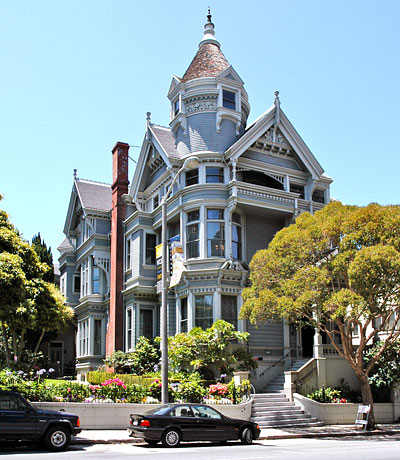San Francisco Landmarks
Haas-Lilienthal House
2007 Franklin Street Between Washington and Jackson
Built 1886
The woodframe Haas-Lilienthal House, designed by architect Peter R. Schmidt for William Haas, is an early Queen Anne at its San Francisco best.
Queen Anne was a late Victorian style which encouraged the architect or builder to abandon the rigid orderliness of earlier Victorians and to let his imagination become more fanciful in treatment of both plan and facades. In his detailing, the architect might incorporate suggestions of the Neo-Classicism that was to emerge full-flower at the 1893 World's Columbian Exposition in Chicago. The major components - entries, bays, windows, rooflines - were frequently organized to avoid any overall symmetry. In unskilled hands this could be disastrous; in the Haas-Lilienthal House, it was a triumph.
The original house was rectangular in plan with a narrow side yard to the south. Sometime after construction, the property to the south was purchased creating a wider yard, to the rear of which a two-story addition by Gardiner Daley was erected in 1928, giving the house its "L" shape of today.
William Haas, who was born in Bavaria, came to the United States in the 1870's. The mining fields of Idaho initially attracted him but on the invitation of his cousin he joined the firm of Loupe and Haas, wholesale grocers in San Francisco, and traveled for them throughout the mining areas of California and Nevada. That firm eventually became Haas Brothers and upon its incorporation in 1897, William Haas became its first president.
Haas had three children. Alice, the youngest, married Samuel Lilienthal, and Lilienthals established residency here in 1917.
Samuel Lilienthal, in addition to being president of the family business, was president of the Federation of Jewish Charities and a member of the Boards of the San Francisco Chamber of Commerce, Wells Fargo Bank, and the California Insurance Company.
Samuel died in 1957. Alice Haas Lilienthal continued to live in the house until her death in 1972.
The heirs donated the house to the Foundation for San Francisco's Architectural Heritage in May 1973.
The National Trust for Historic Preservation holds a façade easement on the property which is listed on the National Register of Historic Places as listing #73000438.
(Source: San Francisco Landmarks Preservation Advisory Board Case Report dated 18 September 1974)
